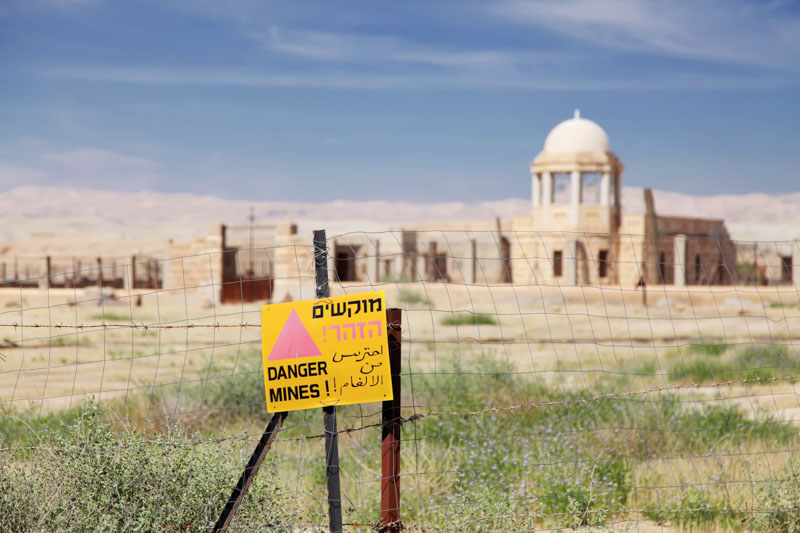
Jerusalem, 20 June 2016
The traditional place where Jesus was baptised by John the Baptist lies at Wadi Kharrar (on the Jordanian bank of the river Jordan), in what the Gospel of St. John calls “Bethany beyond the Jordan” (Jn 1:28). This site has been discovered through the expertise of the late Franciscan archaeologist Fr. Michele Piccirillo OFM, and since the year 2000 it has been developed into a major spiritual centre for pilgrims and tourists in Jordan, with the building of various churches of different Christian denominations, commemorating the event of the Baptism of Jesus. Witness to the importance of this site is given by the Anonymous Pilgrim of Piacenza already in the year 570. He speaks of a cross on a marble pillar in the centre of the river, which commemorated the event of Christ’s Baptism. The current Baptism site in Jordan also commemorates the presence of the prophet Elijah, as well as of other early Christian hermits and pilgrims, including St. Mary the Egyptian.
On the opposite west bank of the river Jordan, in an area currently under Israeli military control, Christians have, for centuries, been used to commemorate Christ’s Baptism, and different Christian churches also have property and had built places of cult on this side of the river, which was more readily accessible for pilgrims arriving in the Holy Land. Ever since 1967, as a result of the war between Israel and Jordan, the whole area has been off-limits for pilgrims and tourists, since it became an enormous minefield (55 hectares) and a military zone. The area is known as Qaser el-Yahud. A restricted access to the river was opened in 2000 for the visit of Pope John Paul II in the Holy Land, and in 2011 the Israeli authorities cleared a small section close to the river, making it easier for pilgrims to approach the Jordan River on the western bank.
This year HALO Trust, which is the world’s largest humanitarian mine clearance organisation, has undertaken the initiative of clearing the whole area of landmines, after agreements stipulated with Israel, the Palestinian Authority and the various Christian Churches involved. In this way it will be possible for pilgrims to approach the site more safely, and the Christian churches will be able to regain the use of their properties which are currently fenced off.
The area in question is the property of eight Christian Churches. The Roman Catholic Church, represented by the Custody of the Holy Land, owns land on the south section of the road linking Jericho to the Jordan River, whereas the Greek Orthodox Patriarchate of Jerusalem owns land directly opposite on the north section. The other Churches which own property to the south of these two respective areas include the Armenian, Coptic, Ethiopian, Romanian, Syrian and Russian Orthodox Churches.
Right at the entrance to the Baptism site stands the Orthodox monastery of the Prodomos (Precursor) at Qasr al-Yahud, the Castle of the Hebrews. The name recalls the place where the people of Israel crossed the river Jordan to enter the Promised Land.
The Custody of the Holy Land is the proprietor of a small round aedicule where the Franciscans celebrate the feast of Christ’s Baptism. According to historical records the Franciscans have gone on pilgrimage to the site at least from 1641. Some distance up from the river the Custody of the Holy Land owns the other larger property mentioned above. It is a square plot of land, at the centre of which there is a small chapel dedicated to St. John the Baptist, blessed and inaugurated on 11 June 1935. Before the war of June 1967 the Franciscans used to come from Jericho to commemorate Christ’s Baptism in this church on the last Thursday of October. After the war of 1967 they continued to come, escorted by the Israeli military, to the round aedicule. The area where the church of 1935 stands is now out of bounds, and signs indicate that it is mined. There are still the stumps of palm trees that used to embellish the property. On the opposite side of the road there is a similar plot of land, the property of the Greek Orthodox Patriarchate (Rosario PIERRI OFM, Nel Luogo del Battesimo di Gesù, in Eco di Terra Santa [Jan-Feb 2013]).
The Franciscans of the Holy Land Custody are now celebrating the commemoration of Christ’s Baptism on the feast of the Lord’s Baptism, on the Sunday following the Epiphany (6 January). The river bank has been developed by the Israeli military authorities in order to make it possible for pilgrims to approach the water. When the whole area becomes clear of landmines, it will be possible to accomodate the thousands of pilgrims to visit the Jordan River in the various places of worship, the remains of which are still evident.
HALO Trust is encouraging the Christian Churches to raise awareness to the need to clear this enormous minefield, littered with 3,800 landmines. It is estimated the total cost to clear the area will amount to $4 million.
Fr. Noel Muscat, ofm
Visit Halo Trust: https://www.halotrust.org/baptismsite

